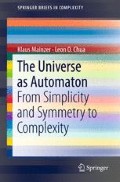Abstract
To answer this question, a deeper analysis of our cosmological models is necessary. In general, principles of symmetry play a central role in physics. The invariance and covariance properties of a system under specific symmetry transformations can either be related to the conservation laws of physics or be capable of establishing the structure of the fundamental physical interactions and forces. This is the most essential aspect of symmetry because it concerns the basic invariance principles of physics and the interactions themselves, and not just the properties of geometric figures (Mainzer 1996).
Access this chapter
Tax calculation will be finalised at checkout
Purchases are for personal use only
Notes
- 1.
In quantum physics, all the properties of a system can be derived from the state or wave function associated with that system. Formally, a phase transformation of the wave function ψ(x, t) can be written as \( \psi(x,t) \to \psi^{\prime} (x,t) = e^{i\alpha} {\psi} (x,t) \) where α is the parameter (or phase) of the transformation (Mainzer 2005b). If α is constant, i.e., the same for all points in space–time, the equation expresses the fact that once a phase convention has been made at a given point in space–time, the same convention must be adopted at all other points. This is an example of a global transformation applied to the field ψ(x, t). If α = α(x, t) is a function of space and time, then such a transformation will not leave any equation of ψ(x, t) with space or time derivatives as invariant. This is, in particular, true for the Schrödinger equation or any relativistic wave equation for a free particle. To satisfy the invariance under a local phase transformation it is necessary to modify the equations in some way, which will no longer describe a free particle. Such modifications introduce additional terms, which describe the interaction of the particle with external fields and thereby generate the dynamics. That is the gauge principle or principle of local symmetry, according to which the interactions are determined by invariance under local symmetry (phase or gauge) transformations (Frampton 2008).
References
J. Audretsch, K. Mainzer (eds.), Wieviele Leben hat Schrödingers Katze? Zur Physik und Philosophie der Quantenmechanik, 2nd edn. (Spektrum Akademischer, Verlag, Heidelberg, 1996)
L.O. Chua, CNN: A Paradigm for Complexity (World Scientific, Singapore, 1998)
D. Deutsch, Quantum Theory, the Church-Turing Principle and the Universal Quantum Computer, Proc. R. Soc. Lond. A 400, 97–117 (1985)
P.H. Frampton, Gauge Field Theories, 3rd edn. (Wiley-VCH, New York, 2008)
R. Giles, C. Thorn, Lattice approach to string theory. Phys. Rev. D 16, 366 (1977)
J. Goldstone, Field theories with ‘superconductor’ solutions. N. Cimento 19, 154–164 (1961)
S.W. Hawking, J.B. Hartle, T. Hertog, The no-boundary measure of the universe. Phys. Rev. Lett 100, 201301 (2008)
P.W. Higgs, Broken symmetries, massless particles, and gauge fields. Phys. Lett. 12, 132–133 (1964)
A.G. Hoekstra, J. Kroc, P.M.A. Sloot (eds.), Simulating Complex Systems by Cellular Automata (Springer, Berlin, 2010)
K. Mainzer, Symmetries of Nature (De Gruyter, New York, 1996) (German 1988: Symmetrien der Natur. De Gruyter: Berlin)
K. Mainzer, Symmetry and Complexity: The Spirit and Beauty of Nonlinear Science (World Scientific, Singapore, 2005a)
K. Mainzer, Symmetry and complexity in dynamical systems. Eur. Rev. Acad. Eur. 13, 29–48 (2005b)
K. Mainzer, Thinking in Complexity. The Computational Dynamics of Matter, Mind, and Mankind (Springer, Berlin, 2007)
M. McGuigan, Quantum cellular automata from lattice field theories (2003), http://arxiv.org/ftp/quant-ph/papers/0307/0307176.pdf
G. ‘t Hooft, K. Isler, S. Kalitzin, Quantum field theoretic behavior of a deterministic cellular automaton. Nucl. Phys. B 386, 495 (1992)
Author information
Authors and Affiliations
Corresponding author
Rights and permissions
Copyright information
© 2012 Klaus Mainzer
About this chapter
Cite this chapter
Mainzer, K., Chua, L. (2012). Outlook: Is the Universe a Computer?. In: The Universe as Automaton. SpringerBriefs in Complexity. Springer, Berlin, Heidelberg. https://doi.org/10.1007/978-3-642-23477-4_9
Download citation
DOI: https://doi.org/10.1007/978-3-642-23477-4_9
Published:
Publisher Name: Springer, Berlin, Heidelberg
Print ISBN: 978-3-642-23476-7
Online ISBN: 978-3-642-23477-4
eBook Packages: Physics and AstronomyPhysics and Astronomy (R0)

